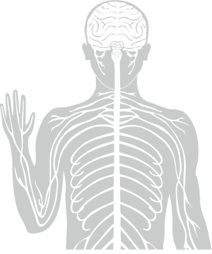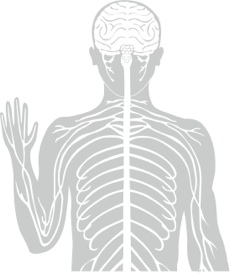Introducing new theory in the study of neuroscience
Impulsing in the Nervous System
Overview: Impulsing in the conscious pathways ...
from the body’s periphery, to the central nervous system, and back ( 3 ) of ( 8 )



Introducing new theory in the study of neuroscience
Impulsing in the Nervous System
Overview: Impulsing in the conscious pathways ...
from the body’s periphery, to the central nervous system, and back ( 3 ) of ( 8 )
Illustration list
1.body or 1/2 body colored into 4 sections and / or arrows showing impulsing directions: organizations of specialized neurons in groups, making up sections of conscious pathways (arbitrarily divided)
2.Section 1: body periphery to Thalamus: activity patterns: absorbing (converging inward), converging at ganglia / other groups in route, diverging at thalamus ... with reel, with color filled in and labeled
3.Section 2: Thalamus to cortex: diverging from thalamus to cortex, converging in cortex to fuse neurons, diverging as residual energy diffuses into adjacent networking ... with reel, with color filled in and labeled
4.Section 3: cortex to thalamus: orientation areas diverging, energy converging on common pattern that is generated to (diverging into component areas) at thalamus ... with reel, with color filled in and labeled
5.Section 4: cortex to body to thalamus: orientation areas diverging, energy converging on common pattern that is generated to (diverging into component areas) muscle landscape ... with reel, with color filled in and labeled
• What causes the experience of sensation in us? Section 1
• How we record each conscious instant? Section 2
• How we form thought? Section 3
• How we form emotional feelings? Section 4
• How sustained impulsing supports emotional health?
After becoming familiar with the idea of impulse trails or impulsing in the pathways of the nervous system ... in which impulse trails evolve, as neuron groups are energized in turn ... and in which converging and diverging patterns of activity evolve in sections of the system, we can now use the concept and see what it does. Much like applying the power of electricity to different appliances to see the wide variety of work accomplished in these specialized electronic configurations, we’re going to apply impulsing to four sections of the system’s conscious pathways ... to see how the specific work of converging and diverging impulse trails in these pathways form our day-to-day conscious stream.
This inner circuitry of integrated pathways is a natural place to start because activity in these pathways is responsible for what we are already familiar with ... the sensations, thoughts and emotional feelings that make up the content and quality of our lives, and that of those we interface with throughout our lives. We start with the section that puts sensations into the track of discrete experiences we call the conscious stream ... sensations of (in evolving, routine patterns) sounds, sights, smells, and pressures we feel, etc. defines our environments as well as establishes routes (the pattern of conscious instants and actions that take us from a sense of need (or stress) state to its relief.) In the next section, each of these conscious instants is recorded, into a network of records, accessible in the future. After being recorded, the conscious instant pattern diverges in the networking to energize records made in the past.
Then in the next section we see how, when a number of incoming trails energized their related networking, that activity can gathered incoming trails,energizes their related network first diverge in the networking we’ve developed, and then converge in that network ... onto a pattern that they first meet at ... deriving thought ... from this network of records ... and (in the last section) orientational emotional feelings. In fact it’s purpose (as it turns out) is tracking a certain level of information we’re exposed to in order to have a current focus that is recorded, and that accesses the network of records made in the past ... as resources for supporting ongoing monitoring and resolving ... the impulsing that we reply on for maintaining wellness. Specifically, with this insight, we see what it takes to maintain the balanced cycling that is the basis of emotional wellness.
In this section, we’ll see:
• As the numerous impulse trails from the body’s sensory groups are constantly cycling in the conscious pathways, how can be keep that cycling steadily resolving so that stagnant states don’t evolve?
•how do we cycle through these sections, starting with units of cycling, then patterns of using of cycling activity to form a lifestyle that is emotionally healthy ... and supports the same in others?
What causes us to experience an instant of sensation?

How do we form thought?
How do we record a conscious instant?
How do we form emotional feelings?

How does sustained impulsing support emotional health?
How do we generate sustained cycling through the sections of these conscious pathways ... to continuously restore and maintain emotional health?

visualize:
< an energized receptor group >
< show ... >
< series of energized neuron groups >
< trail splitting at thalamus >
< series of energized neuron groups >

Section 1
As energy is absorbed, impulsing energizes the series of groups from sensory receptors to the thalamus of conscious pathways, each sequential group, as it’s energized, leaves a tiny impression. When the trail reaches the thalamus, it splits to simultaneously energize a set of thalamus groups, causing a set of impressions to occur … representing the qualities of a conscious instant. Some of these groups (therefore qualities) are sense specific (for example, the color blue is specific to the sense of vision) and the qualities soft is common to many senses.) Impulsing evolves so quickly, these defining impressions, as well as the impressions formed in the energized groups of the preceding impulse trail, are simultaneously active. All together these impressions are experienced as a single unit … an instant of sensation … a frame of sensation, in our ever-evolving conscious stream. The particular sensation experienced depends, of course, on the impressions formed as the trail, from a sensory group to the thalamus, evolved.
Section 2
The qualities of an experienced conscious instant, as defined at the thalamus, maintain split further to reach a layer of their corresponding separate areas (or patch) of the cortex, where its impulses spread over the surface in all directions until the impulses from each area meet and collide. This collision, in effect, fuses just the neurons involved in forming a closed loop … of fused neurons … a permanent open pattern of fused neurons that are no longer resistant to the flow of energy. In other words, the borders between the neurons are softened … or … so that in the future, energy into any part (or qualities) of the pattern, into any part of conscious instant, freely and instantly flows into (energizing) the rest of the pattern. The qualities making up this pattern, are qualities that were also a part of past conscious instants, and go on to energize past records having those qualities, which in turn, energize any past record having any of the qualities of that record .. giving us a sense of recognition as well as orientation. This new routing is new hardwiring, accessible to future conscious instant patterns.
Section 3
The network of records made by the steady stream of conscious instants streaming through the thalamus is, in effect, an ever-evolving filter (hardwiring) through which the current incoming instants can access and energize past related experiences, and where current incoming instants can gather to be resolved. So when the networking is energized by the current instants … and when that energy in the networking converges, the resulting reinforced pattern defines the relationship of the incoming instants and generates a trailhead to the thalamus that we experience as a thought … the next instant of the conscious stream.
Section 4
A different set of current instants energize a different area filter to produce a different area of the overall filter.
The personal networking we develop also derives (as current instants converge within it) a range of emotional feelings: reflections of current sensation and thought generate reflective feelings that range from a very subtle sense of orientation, to a greater level of tension getting our attention, to a sense of need, and on more increased tension, which we experience as stress, which can increase to degrees of emotional pain … and back through reverse degrees of relief … as these tensions are relieved. In addition, when these reflective patterns of emotion are generated when we sub-consciously attempt to feel the relate to the same feeling of another, for example, and when reflective emotion patterns gather on the body landscape, other familiar emotions emerge … as instants of emotion into the everyday conscious stream. So Emotion also springs, in two-stages, from the networking as the related areas of current conscious instants converge, to derive an impulse trailhead to muscle tissue—orienting the body to the presence of sensation and thought (through the patterns of tones they have in common). In addition, the conscious pathways takes the additional step of continuing that body reflection until the thought or sensation is resolved—resolved by fading into the networking, or having its energy used in generating a new trail. So the body registers the efficiency of resolutions—as degrees of reflective stress with, at best, corresponding (balanced) relief.
(c) Denise Ingebo Introducing Impulsing in the Nervous System:
An overview: Impulsing in the conscious pathways ... from the body’s periphery ... to the central nervous system ... and back www.impulsing.org